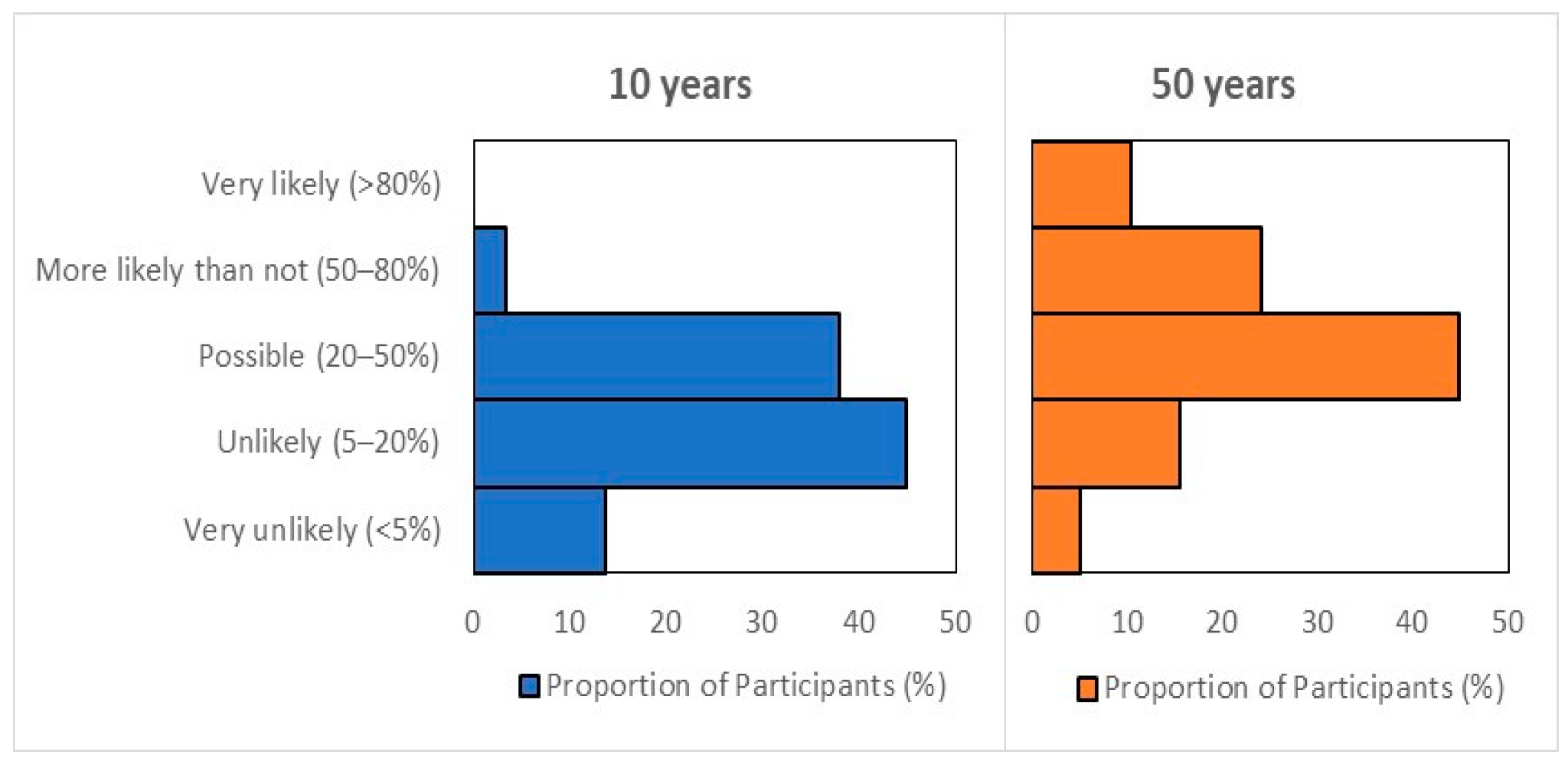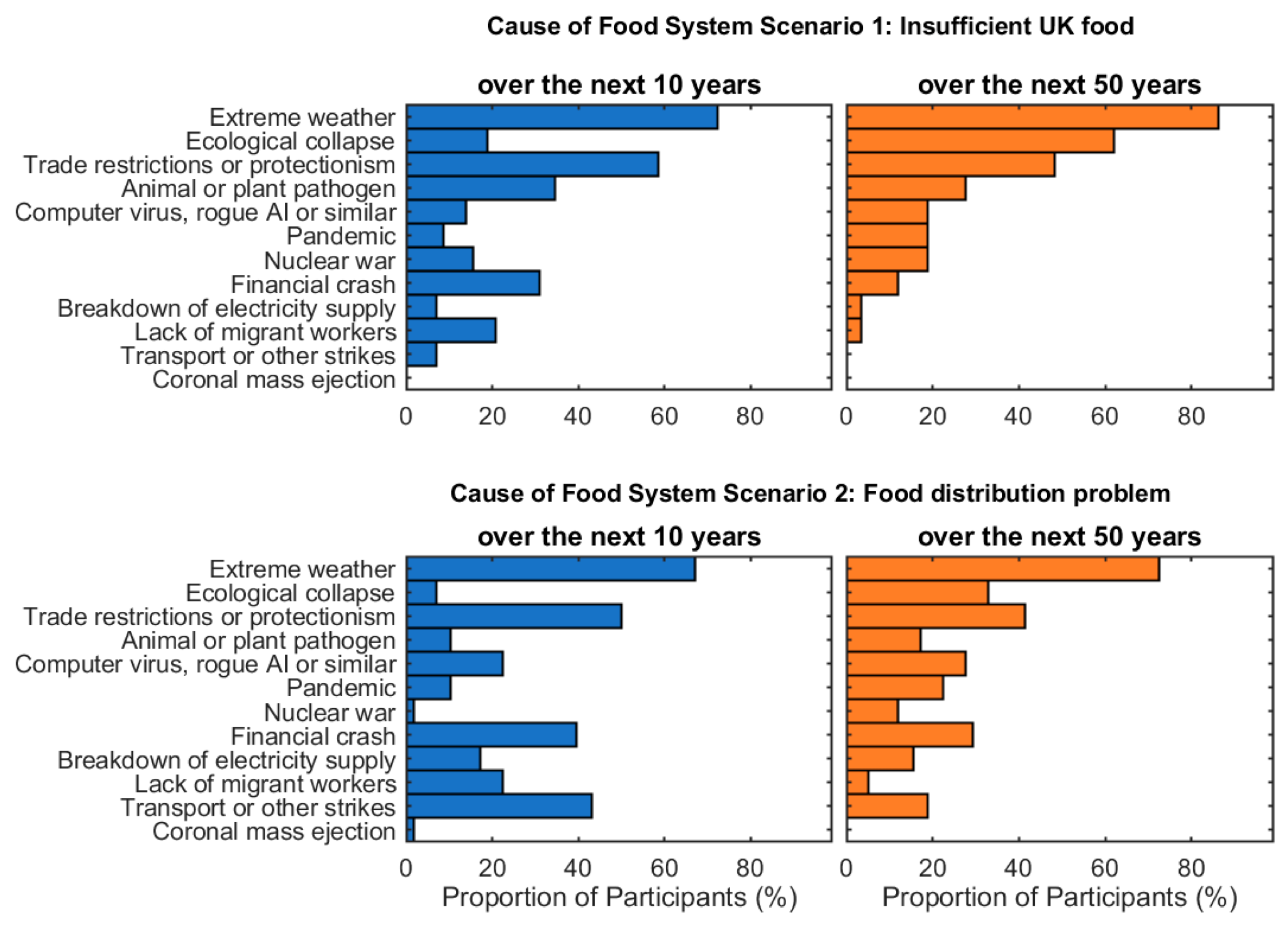This paper reports the results of a structured expert elicitation process from 76 food system experts on future food system disruption scenarios for the UK. Around one third of those consulted thought that major civil unrest due to a shortage of popular carbohydrates as a result of extreme weather was more likely than not in the next 10 years.

Summary
The global food system has been optimised for efficiency, sometimes with little or no redundancy at individual points, and with a high degree of temporal coordination (‘just-in-time’ delivery), leaving little safety net for disruption. Increasingly extreme weather patterns associated with climate change are causing crop failures and it is possible in the future that multiple breadbaskets (food production regions) will experience simultaneous crop failure, leading to major disruption in the global food supply chain. Impacts of such events in specific countries could be compounded by global trade disruptions (for example protectionism) or other events such as pandemics, war, land degradation or local disruption at global choke points. These dynamics can create food insecurity, which can be amplified in a given country by inequalities of access and uneven distribution of food, and economic factors such as loss of income and volatile food prices. Food insecurity is often identified as both a cause and consequence of catastrophic civil unrest events, defined here as events where more than 30,000 people are injured as a result of violent protests.
The UK currently imports just under half its food on boats, planes and trains, making it particularly vulnerable to global food supply chain disruption. There have been several recent short-term food disruptions in the UK: first Brexit caused delays with imports, uncertainty over regulations and disruption to seasonal migrant workers; next COVID-19 caused demand side disruption through panic buying and stockpiling; finally the cost-of-living crisis increased energy prices and food prices, rapidly increasing food insecurity.
This paper aims to assist with preparations to avoid future UK food system catastrophe by identifying the most likely drivers. Through identifying drivers, efforts to mitigate catastrophe can be organised and emergency response plans to reduce societal impact can be made. The paper uses data from a survey distributed to 76 food system experts, who were given a set of multiple choice and open ended questions. The participants were asked to answer six questions for a 10-year timeframe, and then repeated the questions for a 50-year timeframe. The first question asked the participants to estimate the likelihood of civil unrest and the second asked which of two broad types of food system disruption might have caused this unrest: an overall lack of food availability or problems with food distribution. The next pair of questions asked participants to rank the cause of the insufficient food and distribution problem scenarios from a predetermined list. The final two questions asked which type of commodity shortage (popular carbohydrates, most carbohydrates, fruit and vegetables, dairy or eggs, or meat or fish) caused the disruption for the two scenarios. Two of the categories, popular carbohydrates and most carbohydrates, overlapped; this allowed a distinction between an apparent shortage (lack of desired product) and a calorific shortage where non major staples are available.
The results of the top level question can be seen below. Just over 40% of the food experts surveyed believe that civil unrest in the UK in the next 10 years was either possible (38%) or more likely than not (3%). Over the next 50 years, this increased to nearly 80% of experts believing civil unrest was either possible (45%), more likely than not (24%), or very likely (10%).

Fig 1. Plausibility of the Societal Event as a function of time. (Jones et. al.,2023)
On a 10-year timeframe, 80% of respondents thought food distribution would be the cause of civil unrest, whilst in 50 years, this conclusion was reversed, with over half of the participants predicting insufficient food being available in the UK. Extreme weather was the most commonly identified driver, with 85% of participants identifying it in the 50 years scenario and coronal mass ejections (a large release of plasma from the surface of the sun) the least commonly identified (see below).

Fig. 2 Results of asking participants about the causes of Food System Scenario 1 (insufficient UK food, upper panels) and Food System Scenario 2 (food distribution problem, lower panels) (Jones et. al.,2023)
There was also the opportunity to list other potential causes beyond the multiple-choice list. Several participants identified food contamination events as a particular concern, with additional causes including wider breakdown in cooperation within society, non-nuclear war and the rise of fascist politics identified by others. Several participants identified other wider societal risks such as poverty, population increase and ageing, and feedback responses such as panic-buying and hoarding. The researchers conclude that across these responses, it was clear that participants felt that a combination of facts, rather than a single driver, would cause disruption.
In response to the final question, in both the short and long term scenario popular carbohydrates were identified as the most likely to cause disruption, whilst fruit and vegetables were second and dairy and eggs of least concern.
Overall, almost a third of participants said there was a greater than 20% chance of civil unrest in the next 10 years due to food distribution problems caused by extreme weather, with popular carbohydrates the affected commodity. Over 50 years, this increased to almost half of participants identifying the same chance of civil unrest.
Abstract
We report the results of a structured expert elicitation to identify the most likely types of potential food system disruption scenarios for the UK, focusing on routes to civil unrest. We take a backcasting approach by defining as an end-point a societal event in which 1 in 2000 people have been injured in the UK, which 40% of experts rated as “Possible (20–50%)”, “More likely than not (50–80%)” or “Very likely (>80%)” over the coming decade. Over a timeframe of 50 years, this increased to 80% of experts. The experts considered two food system scenarios and ranked their plausibility of contributing to the given societal scenario. For a timescale of 10 years, the majority identified a food distribution problem as the most likely. Over a timescale of 50 years, the experts were more evenly split between the two scenarios, but over half thought the most likely route to civil unrest would be a lack of total food in the UK. However, the experts stressed that the various causes of food system disruption are interconnected and can create cascading risks, highlighting the importance of a systems approach. We encourage food system stakeholders to use these results in their risk planning and recommend future work to support prevention, preparedness, response and recovery planning.
Reference
Jones, A., Bridle, S., Denby, K., Bhunnoo, R., Morton, D., Stanbrough, L., Coupe, B., Pilley, V., Benton, T., Falloon, P. and Matthews, T.K., 2023. Scoping potential routes to UK civil unrest via the food system: results of a structured expert elicitation. Sustainability, 15(20), p.14783.
Read the full report here




Comments (0)